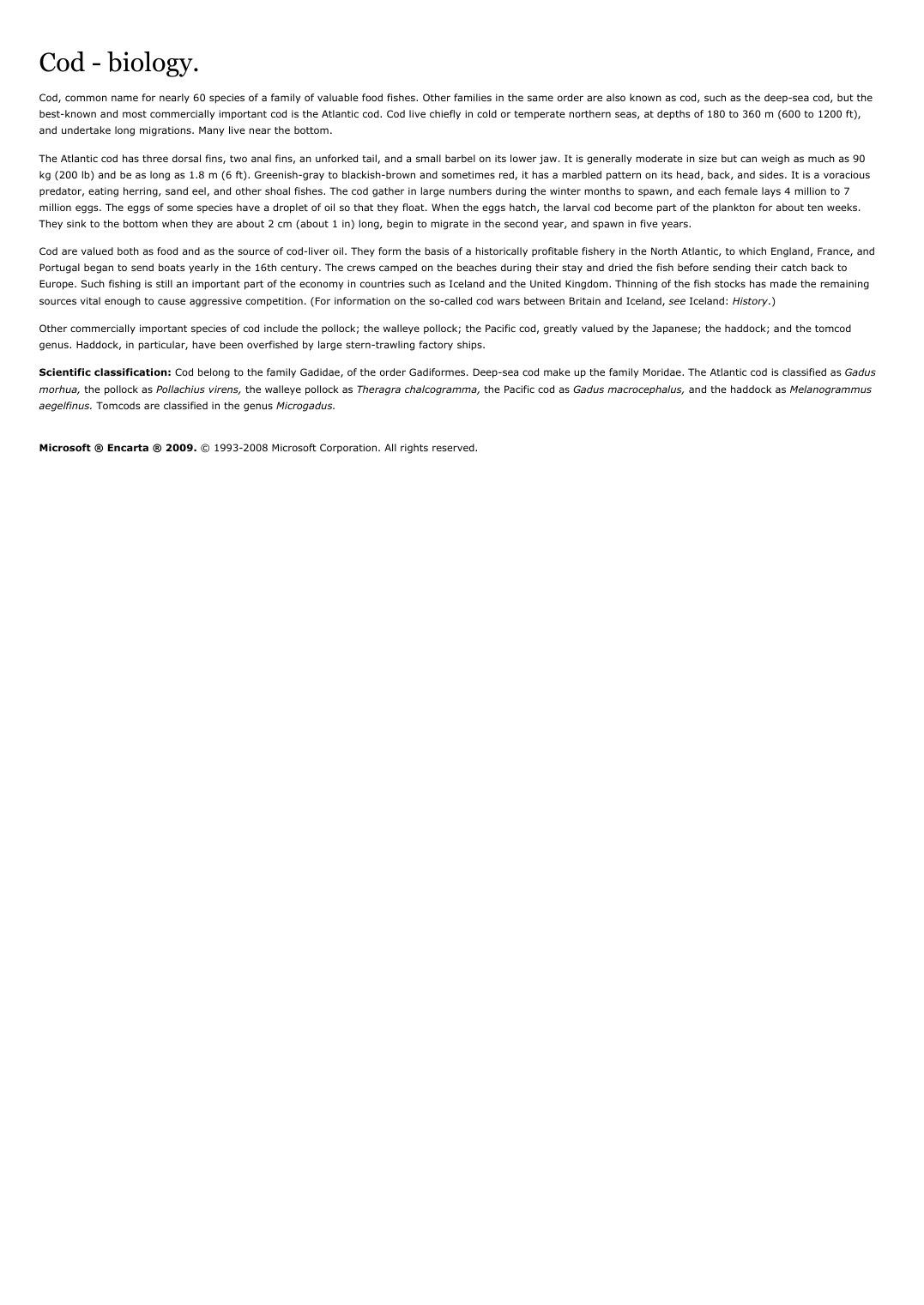Cod - biology.
Publié le 06/12/2021

Extrait du document
Ci-dessous un extrait traitant le sujet : Cod - biology.. Ce document contient 444 mots. Pour le télécharger en entier, envoyez-nous un de vos documents grâce à notre système d’échange gratuit de ressources numériques ou achetez-le pour la modique somme d’un euro symbolique. Cette aide totalement rédigée en format pdf sera utile aux lycéens ou étudiants ayant un devoir à réaliser ou une leçon à approfondir en : Echange
Cod - biology.
Cod, common name for nearly 60 species of a family of valuable food fishes. Other families in the same order are also known as cod, such as the deep-sea cod, but the
best-known and most commercially important cod is the Atlantic cod. Cod live chiefly in cold or temperate northern seas, at depths of 180 to 360 m (600 to 1200 ft),
and undertake long migrations. Many live near the bottom.
The Atlantic cod has three dorsal fins, two anal fins, an unforked tail, and a small barbel on its lower jaw. It is generally moderate in size but can weigh as much as 90
kg (200 lb) and be as long as 1.8 m (6 ft). Greenish-gray to blackish-brown and sometimes red, it has a marbled pattern on its head, back, and sides. It is a voracious
predator, eating herring, sand eel, and other shoal fishes. The cod gather in large numbers during the winter months to spawn, and each female lays 4 million to 7
million eggs. The eggs of some species have a droplet of oil so that they float. When the eggs hatch, the larval cod become part of the plankton for about ten weeks.
They sink to the bottom when they are about 2 cm (about 1 in) long, begin to migrate in the second year, and spawn in five years.
Cod are valued both as food and as the source of cod-liver oil. They form the basis of a historically profitable fishery in the North Atlantic, to which England, France, and
Portugal began to send boats yearly in the 16th century. The crews camped on the beaches during their stay and dried the fish before sending their catch back to
Europe. Such fishing is still an important part of the economy in countries such as Iceland and the United Kingdom. Thinning of the fish stocks has made the remaining
sources vital enough to cause aggressive competition. (For information on the so-called cod wars between Britain and Iceland, see Iceland: History.)
Other commercially important species of cod include the pollock; the walleye pollock; the Pacific cod, greatly valued by the Japanese; the haddock; and the tomcod
genus. Haddock, in particular, have been overfished by large stern-trawling factory ships.
Scientific classification: Cod belong to the family Gadidae, of the order Gadiformes. Deep-sea cod make up the family Moridae. The Atlantic cod is classified as Gadus
morhua, the pollock as Pollachius virens, the walleye pollock as Theragra chalcogramma, the Pacific cod as Gadus macrocephalus, and the haddock as Melanogrammus
aegelfinus. Tomcods are classified in the genus Microgadus.
Microsoft ® Encarta ® 2009. © 1993-2008 Microsoft Corporation. All rights reserved.
Cod - biology.
Cod, common name for nearly 60 species of a family of valuable food fishes. Other families in the same order are also known as cod, such as the deep-sea cod, but the
best-known and most commercially important cod is the Atlantic cod. Cod live chiefly in cold or temperate northern seas, at depths of 180 to 360 m (600 to 1200 ft),
and undertake long migrations. Many live near the bottom.
The Atlantic cod has three dorsal fins, two anal fins, an unforked tail, and a small barbel on its lower jaw. It is generally moderate in size but can weigh as much as 90
kg (200 lb) and be as long as 1.8 m (6 ft). Greenish-gray to blackish-brown and sometimes red, it has a marbled pattern on its head, back, and sides. It is a voracious
predator, eating herring, sand eel, and other shoal fishes. The cod gather in large numbers during the winter months to spawn, and each female lays 4 million to 7
million eggs. The eggs of some species have a droplet of oil so that they float. When the eggs hatch, the larval cod become part of the plankton for about ten weeks.
They sink to the bottom when they are about 2 cm (about 1 in) long, begin to migrate in the second year, and spawn in five years.
Cod are valued both as food and as the source of cod-liver oil. They form the basis of a historically profitable fishery in the North Atlantic, to which England, France, and
Portugal began to send boats yearly in the 16th century. The crews camped on the beaches during their stay and dried the fish before sending their catch back to
Europe. Such fishing is still an important part of the economy in countries such as Iceland and the United Kingdom. Thinning of the fish stocks has made the remaining
sources vital enough to cause aggressive competition. (For information on the so-called cod wars between Britain and Iceland, see Iceland: History.)
Other commercially important species of cod include the pollock; the walleye pollock; the Pacific cod, greatly valued by the Japanese; the haddock; and the tomcod
genus. Haddock, in particular, have been overfished by large stern-trawling factory ships.
Scientific classification: Cod belong to the family Gadidae, of the order Gadiformes. Deep-sea cod make up the family Moridae. The Atlantic cod is classified as Gadus
morhua, the pollock as Pollachius virens, the walleye pollock as Theragra chalcogramma, the Pacific cod as Gadus macrocephalus, and the haddock as Melanogrammus
aegelfinus. Tomcods are classified in the genus Microgadus.
Microsoft ® Encarta ® 2009. © 1993-2008 Microsoft Corporation. All rights reserved.
↓↓↓ APERÇU DU DOCUMENT ↓↓↓


